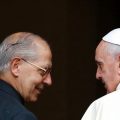Let Their Voices Be Heard!
Let people’s voices be heard, Pope Francis tells the church. Not just the voices of the clergy and those who speak from the altar, but the voices of those who are normally silent. The voices of those who sit quietly in the pews, and even those who have stopped attending church altogether. The call for a church synod is to make this happen.
Here on Guam the synod is to be formally opened with an evening mass at the cathedral on December 7. It is a process that will continue on island for six months, beginning with a series of open meetings at the parish level that will be held throughout the first three months of the coming year.
The summons to speak and listen is all the more important in this current age of strong divisions in the church, not to mention the world at large.
To some the church has become a symbol of division: an institution drawing a line between God and the world, the holy and the sacred, good and evil. Its proclamation seems to be: You must do this, but not that. Always defining, always regulating, always keeping people in line.
Yet, Vatican II envisioned the church as working to unite people as a community that should be the expression of the unity that all of us are called to, whatever the differences in language, culture and political affiliation. In the end, even diverse religious beliefs cannot divide us. The church should be singing a hopeful and welcoming note to the people of the planet who desperately need something to rejoice in.
Yet, the undeniable fact is that the church has its own divisions—plenty of them. The language of the liturgy, English or Latin? Same-sex marriage? Ordination of women priests? Denial of communion to political leaders who support legalized abortion? And lots of less visible questions besides. These and other issues have driven people out of the church they grew up in. None of this, of course, is any surprise to folks here on Guam who have repeatedly felt their own burden of divisiveness over the past several years.
It’s no surprise that the reaction of secular society to the church’s mission to unite is, to paraphrase that biblical text, “Physician, heal yourself before you try to peddle your wares to us.” There’s much work to be done unifying the church itself if it is to presume to be a credible symbol of the unity of all peoples.
The synod is a start to this healing. Healing always begins by listening to the voices of those who might disagree before moving on to take action.
What comes after this? Reflection on what was said—but with the realization that the forces of reform in the church have often been needed, and they have often come from the outside—monks, founders of religious orders, prophets of the church through its history. Any action plan will stem from this.
The synod begins, as real conversation must, at the ground floor. Parishes will be running meetings for local groups. What is said will be synthesized and offered to the diocese, before this is passed on to the regional councils and eventually to Rome. We can hope that what is recorded will move the church forward, making it a more forceful sign of the unity and love that it should represent.
The process, as Austen Ivereigh writes, will be “tense, messy, humble, but an open square for all.” But there is a joyful “confidence that the people of God will, over time, hear the call to assemble. And when they do, that they will speak boldly and listen carefully, and that somehow, in spite of all the resistance and obstacles, not another but a different church will come forth.”
A church that can speak more credibly about its mission to unite people, even as it proclaims a message of hope.






